Electronic visual distress signals: Sirius Signal (Weems & Plath) versus Orion, plus a new option
In 2015 I enjoyed testing, and then enthusing about, the first electronic distress signal that could effectively and legally replace the flares required on most of our boats by the US Coast Guard. Hot flares always struck me as a dangerous way to seek help, they are distinctly unpopular with the folks who protect our environment, and their short lifespan is a boating hassle.
Now the original SOS C-1001 “LED flare” I wrote about — designed and engineered by Sirius Signal, and currently distributed by Weems & Plath — has competition from Orion Safety, the company that manufactures most actual marine pyrotechnic flares. It’s good news, I think, that Orion has finally endorsed the electronic Visual Distress Signal Device (eVDSD) concept — yes, it even has an acronym now — but which is better? Sirius Signal thinks it knows the answer, and loaned me a comparison kit to see for myself.
So what follows is my comparison of the two competing SOS distress signals, which both sell for $90 at West Marine and other outlets. First we’ll look at the design differences, though I also tried testing them on the water, and finally I’ll share news about an expansion of the eVDSD standard that looks quite interesting.
The slightly larger Orion only opens at the bottom and is powered by two D cells while the Sirius Signal (Weems & Plath) can be entirely dissembled from the top and uses three C-size batteries. All of which is important because, as the West Advisor notes, a significant drawback of an electronic non-pyrotechnic device is that it “uses batteries that can leak, corrode or fail” to which I’ll add the overall issue of many safety devices not receiving the maintenance attention they deserve. (I’m guilty too.)
If a battery did corrode inside the Sirius Signal design, you could access every part for cleaning. In fact, according to Sirius, you can purchase any part that needs replacement. Also, as noted in the comments to my 2015 review, Sirius included a platinum catalyst — that little box glued to the inside of the naked black electronics cup above — meant to protect against the outgassing of a failing alkaline battery. Nice!
I’ve also come to appreciate Sirius’s careful engineering of the on/off switch and power path, always potential points of failure, especially when rarely used. The left photo shows how the one-piece copper battery spring and negative power conductor fit into the Sirius case so that its springy tip can engage the large aluminum contact area on the back of the electronics cup (at right) when you screw the lens down a couple of turns. You can also see the large copper positive contact on the cup, and how all conducting contact surfaces are self-cleaning with the twisting motion. Moreover, the Sirius is arguably easier on the switching path than the Orion because it uses 4.5v instead of 3v to produce the same mandated light intensity levels, and thus less current.
Inside the Orion
By contrast, the Orion SOS Beacon had to be sawn and pried apart so that Sirius (and then I) could examine the innards. The sealed air volume — with the double o-ringed battery cap in place — and the larger size do give this beacon more buoyancy than Sirius’s combination of foam flotation collar and sealed air, which seemed a plus in testing. And the Orion can also be turned on with one hand.
But, dang, if that switch fails or a leaky battery otherwise fouls up the power path, an Orion SOS distress signal owner is going to have a hard time diagnosing the problem, let alone fixing it.
While Sirius also sent me lenses they had sawn and blackened to reveal the optical designs, I’ll leave comparative comments to informed readers as I’m pretty dim on that subject (which is also why I accidentally posed the small Orion cutaway at left upside down). But I did take untampered-with Orion and Sirius Signal lights with fresh batteries out on Penobscot Bay.
Testing the lights
So Gizmo’s first trip of 2019 was a twilight cruise in late April with old buddy Alden Cole as mate and a second set of independently judgemental eyes. But, cutting to the chase, such testing is tricky and neither of us detected significant differences in the eVDSD performance (again that stands for the formal title “electronic Visual Distress Signal Device”).
I actually shot this clip after we’d returned to Gizmo’s float, but it does give a close view of how the distress lights float and flash Morse code SOS. Note too how the Sirius Signal design at left is a little lower in the water, which from a distant low angle seemed to make it a tiny bit less visible. Then again, that perception may have been because it was more obscured by the life jacket we attached to make each light easier to pick up. (Plus Sirius Signal tells me that they’ve designed a production line change that will cause newly manufactured signals to float a little higher.)
My phone camera brightened this scene more than real life but much of our testing was at last twilight as the two distress lights drifted down the Bay. This was taken from Gizmo’s upper deck where the life jackets did not obscure the lights, and both seemed about equally as bright and consistent. Sorry the video isn’t longer, but you can see how the darn lights tried to fetch up on a rocky shore, which led to a somewhat hairy retrieval.
Besides, I don’t think any video like this can substitute for actually being there. For us the lights were pretty much equal at about the half mile maximum distance we got. And, by the way, I did inform the local and very cooperative Coast Guard about this testing beforehand, though I don’t know if anyone called to report seeing the distress lights. (I doubt it as a lot of the shore homes are still empty and Gizmo circling the scene was likely a tip-off anyway.)
But we did wonder how visible these beacons would be if there were lots of shore lights in the background, and I’m glad to report that the eVDSD standard expansion I mentioned permits distinct colors in addition to white. But before I get into detail, I have more than little to say about which current eVDSD I would buy.
What I’d buy
First, in my view, the Sirius Signal (Weems & Plath) product design beats Orion’s by a wide margin. The latter’s single-handed switching and slightly higher float position just don’t strike me as major factors when I envision all the ways an eVDSD might be used in a real distress situation. But reliability does, and I’m quite impressed with how well Sirius engineered it in.
But there’s a whole other factor that would color my buying decision, and that’s how Orion Safety reacted when the original Sirius Signal device came to market. Shortly after I wrote the Electronic Flare entry in 2015, I received an email from Orion’s marketing director that went in part like this:
Interesting article on the new LED light by Sirius, I read online. I think consumers should be made aware they are buying a soon to be unapproved signal. The Coast Guard has been in the process of developing an electronic alternative/supplement to hand flares for the past 3 years. I am a member of the committee convened to develop the new specification. We are hoping to finalize a draft this year to be submitted to the Coast Guard for further evaluation and testing… At a minimum I think consumers and your readers should be made aware they are spending $100 for a signal soon to be an unacceptable alternative for a hand flare. I suggest they save their money and wait till the new product becomes available hopefully in 2016.
I investigated this claim only to find that the (not really public) draft report was much vaguer than cited, and then the Orion guy stopped answering my pesky questions about it. Besides, I’d already seen other USCG safety regulation changes move along a much slower timeline — heck, I got close to whiny about Class B AIS — and also knew that they are very careful about causing boaters unnecessary expense (by regulation).
My skepticism has stood the test of time. The Sirius Signal (Weems & Plath) eVDSD was not made an “unacceptable alternative for a hand flare” in 2016 or any year since, and there’s no indication that it or the Orion model will be. In fact, I could never find anyone besides Orion who ever thought that would happen.
But that did not stop Orion from muddying the marketplace. Thus the trade show photo (above) that a reader sent in and thus my “The rumor is NOT TRUE” comments on the old entry. I’ve rarely seen that sort of “marketing” in the boating industry (I’m happy to report), and I haven’t forgotten it. I wouldn’t buy anything from Orion Safety unless it was a clearly superior product I felt important. Then again, I’m obviously closer to what happened than most, and your buying decisions are very much your own.
Coming: two color eVDSD
Orion was right about USCG efforts to improve the eVDSD starting back in 2013, and they’re finally coming to fruition. As Sirius Signal notes in this press release, “On December 21, 2018, the USCG issued a Policy Letter accepting red-orange/cyan as official colors to be used in maritime electronic visual distress signal devices (eVDSDs).”
I’ve read that policy letter (online here), and the Guard is exercising their right to “approve an item of equipment that does not meet all of the requirements of 46 CFR 161.013 if it has equivalent performance characteristics.” That’s how the CFR General Performance Standard (1) reading “Emit a white light which…” can now include red-orange and cyan without precluding existing white devices.
I saw Sirius Signal CEO Anthony Covelli demonstrate a prototype red-orange/cyan eVDSD at a 2017 National Boating Safety Advisory Council meeting in Washington, DC, and don’t doubt that a visual distress signal with these two distinct colors flashing SOS can be more effective than what the old standard originally specified. However, there’s more to the story.
I have not seen the RTCM Standard 13200.0 for Electronic Visual Distress Signal Devices that emerged from the extended USCG testing and discussion, but I understand that the expanded specification will be challenging for manufacturers to build at a friendly cost, and thus likely to be a premium safety product, at least at first.
Incidentally, National Safe Boating Week kicks off this weekend, and thus it’s high time for many of us to check out our safety gear in the here and now. Is all your boat’s required equipment fit and functional? What about smart though probably not mandated safety items like an EPIRB, PLB, or SEND; is the registration info that will help SAR services up to date? Most types of boating aren’t actually very dangerous, but when things do wrong there’s often time to turn the situation around with the right aids.
Back on subject, I look forward to covering new eVDSDs as possible, but right now I’m pleased that the basic technology has become so mainstream that even the major U.S. flare company is on board, and that you might even run into a Weems & Plath SOS Distress Light mascot at a boat show.


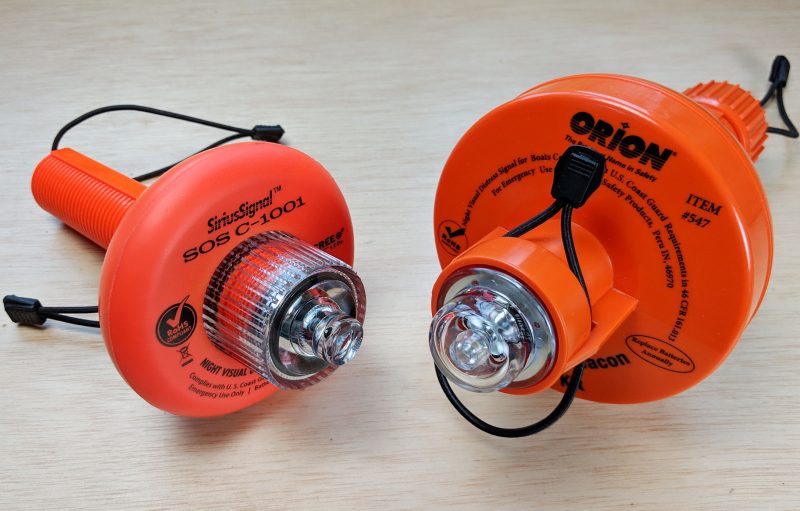
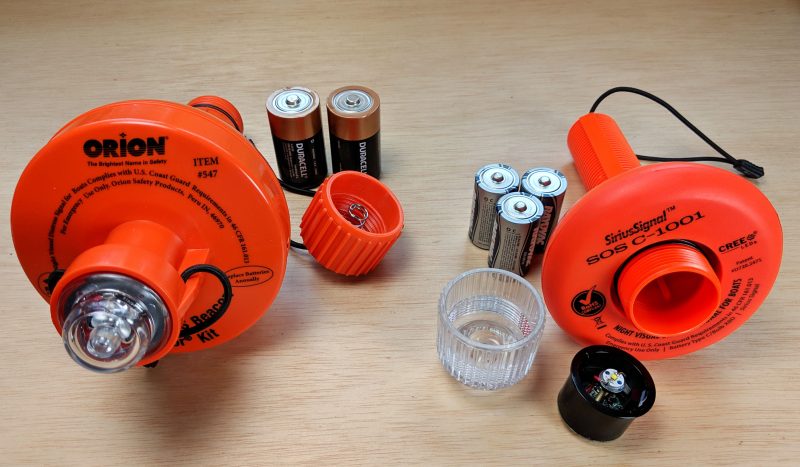




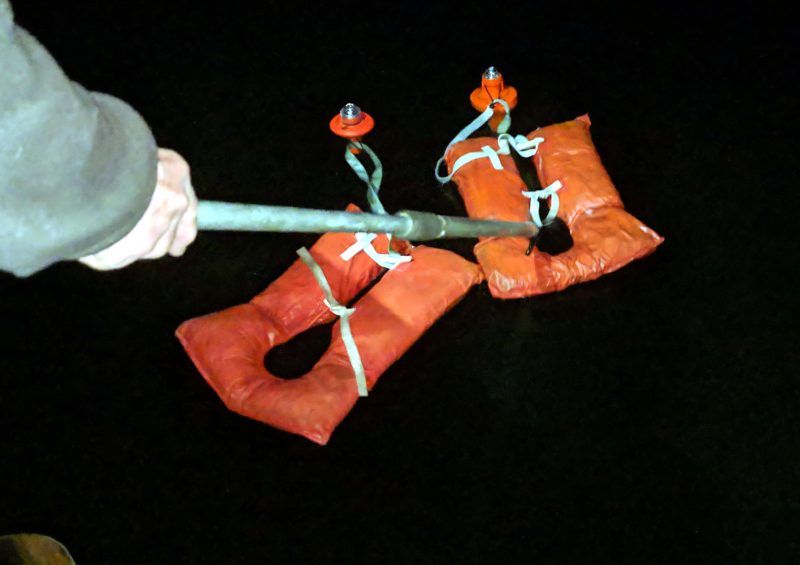



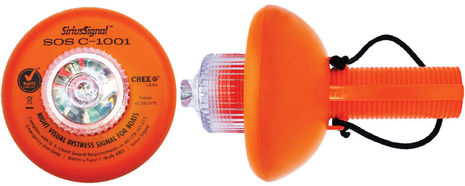
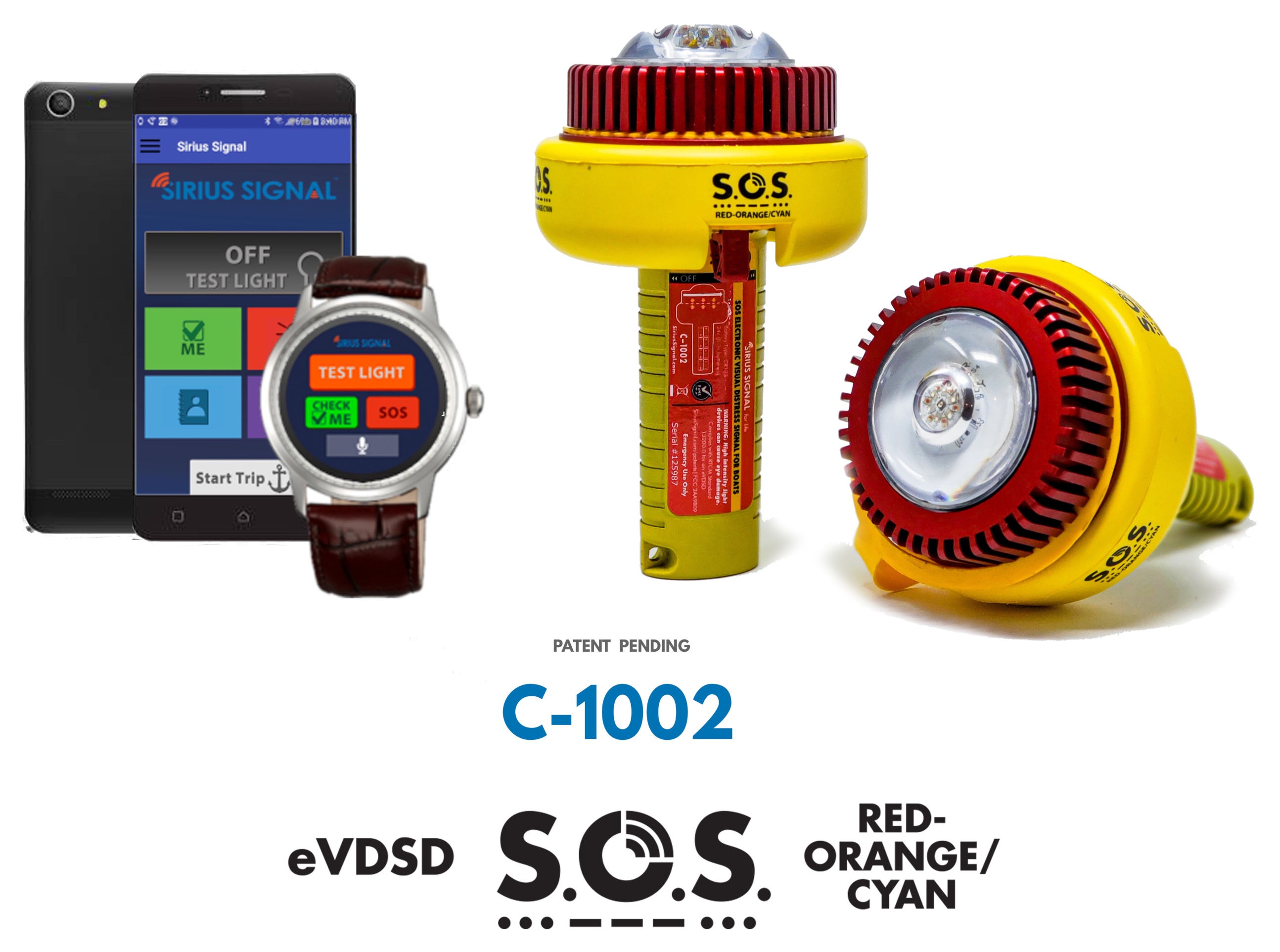
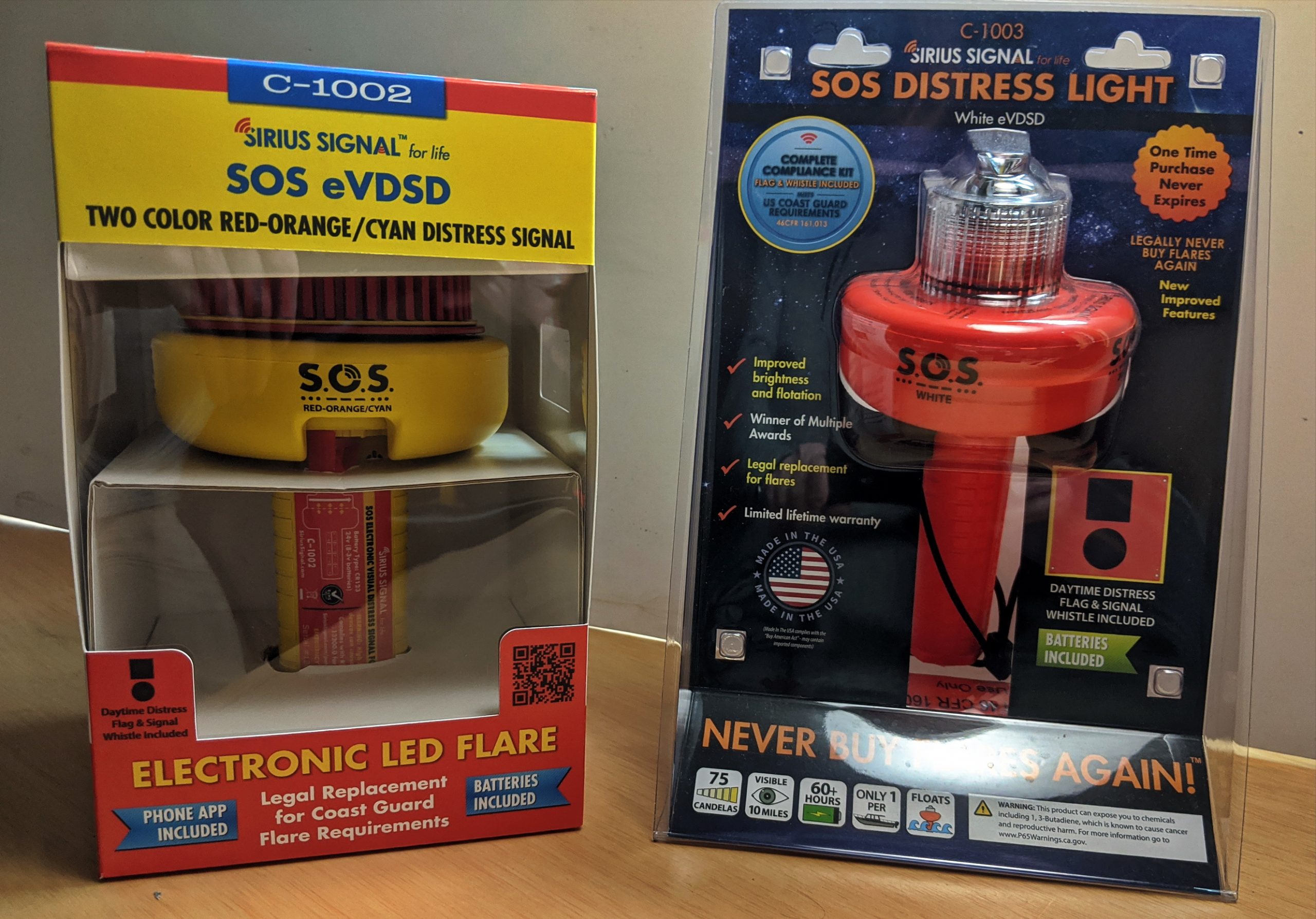









I don’t know if this is just a nice coincidence or a sign of National Boating Safety Week, but last night West Marine put the Weems & Plath (Sirius Signal) SOS Distress Light on sale for $70 (until May 27):
https://www.westmarine.com/buy/weems-plath–sos-distress-light-electronic-flare-with-distress-flag–17466988?recordNum=2
Great comparison, and I especially like the on-the-water testing. I needed a new flare solution for my new-to-me boat a few months ago and stumbled across the Orion product at a pretty decent discount, and ended up getting that instead of the Sirius Signal, which I had on my previous boat.
I can say in general that I prefer the build quality of the Sirius over the Orion just from the outside, including the packaging. However, the Orion one had a prominent place in the store along side all of the other flares, and obviously was trying to recover some of the lost market that Sirius stole from traditional flares.
I’m just glad I don’t have to keep buying the old style dangerous flares anymore!
Thanks for the great breakdown Ben. Orion’s FUD about the Sirius product is just so sad. Clearly they lost the bidding war to get the right to this product, or they didn’t bid at all thinking they could quickly come to market with their own versioin before Weems could get established. They were slow. Weems has a lead and a better product. Orion, however, still has distribution and could win in the end. We’ll see. As for me, I have the SiriusSignal…but I do store it in one of those old orange Orion Tube flare holders….on a mounting clip. It fits in there, with the flag and spart batteries, perfectly. 😉
What I’m more interested in seeing is what Ocean Signal does. Their RescueME EDF1 Electronic Distress Flare doesn’t meet the original spec (it was Red-Orange/Cyan) and still doesn’t have a floating collar. But now that this color is approved, the RescueMe flare is just a floating collar away from passing. It is amazingly bright, and has 4 light settings; Low, High, Ultra High, and Directional. That last one means you can aim the strobing, and not have to blind yourself by looking at the light when it’s on. All that pushes the price up to about $140….but it’s a sweet light.
Thanks for the reminder, Dan. I’ve seen the RescueME EDF1 demoed and thought it well designed and built (like everything I’ve seen from Ocean Signal). But it is still mysterious to me what else besides the colors the RTCM put into their new 13200.0 recommendations for eVDSDs (and that the USCG has agreed to accept as a night signal). It may be that all the manufacturers need new designs (though many were involved in the process).
Of course it is possible to carry pyrotechnics to fulfill the USCG regs and any electronic flare you want to improve your chances of success, as noted here:
https://www.sailmagazine.com/diy/electronic-flares-for-cruisers
Excellent review/comparison. Interestingly, when we created the Weems & Plath SOS Light video a few years ago we actually shot four pyrotechnic flares into the air at night in populated Port Ludlow, WA. Like you, we worked with the USCG and our local fire and police departments. Besides the fact only three out the four flares ignited (one was a dud), no one called the coast guard or the local emergency agencies.
Thanks, Darren. I suspect that most every type of visual distress signal is most effective when the problem has already been communicated by VHF or other means, and someone is actually out there looking for you. Incidentally, I remember enjoying your video: https://www.pacificnwboatertested.com/products/weems-plath-sos-distress-light
The real weakness in these products are the batteries you choose to put in them. As a recreational diver I always used Duracell in my dive lights. But, at some point several years ago I started to get leaking Duracell batteries on a regular bases. (every flashlight onboard is a certified dive light) Keep in mind a dive light for deep diving cost over a hundred dollars. Usually, a leaking battery is not caught in time to avoid destroying the flashlight. In my opinion, it’s not possible to really clean up a flashlight after batteries leak, certainly not well enough to consider the flashlight reliable as it was when new or reliable enough for diving or as an emergency signal. When I bought the Sirius Signal SOS light it came with Rayovac batteries and the literature with it said they carefully evaluated the batteries and found Rayovac least likely to leak. I switched to using them and so far have not had a single leak failure in any device or flashlight. In addition, they seem to last longer than any other battery I have tried. I do not have any scientific data to prove this – just my overall experience. I also, started a system of putting a label on each device indicating the month and year the batteries were new. The Sirius Signal is an exception it gets new Rayovac batteries at the start of each season. Not taking any chances!
Thanks, Richard. I’m not nearly so careful, I’m not proud to say, but maybe I’ve been acting like a more average boater as I long test the Sirius Signal eVDSD I received back in Sept. 2015 (before Weems & Plath took over distribution). It’s been stowed on Gizmo ever since — including getting me through one USCG underway surprise inspection — and Gizmo has been in the water the last 3 of those 4 winters, 2 in Maine, one in NC. I’ve demonstrated it to visitors numerous times, but think I only refreshed the batteries in Sept. 2017 (not sure which brand).
At any rate, I checked the 2015 Sirius Signal it out while testing the new sample, and it’s working fine with zero sign of battery failure. But that doesn’t make me smart, and I am trying to get more disciplined about marking battery changes on all sorts of gear like smoke detectors, keeping a list of PLB registration and battery expire dates, etc. Just having the equipment on board is not the whole job 😉
PS Rayovac has a good story: http://www.rayovac.com/story/our-heritage.aspx
Richard, we, too, have found the “copper top” Duracell batteries to be a leak problem – I’ve even experienced a couple that were still producing power when they leaked. I have found that the “titanium” versions have been trouble-free, but I think they come only in AA and AAA sizes. For my C- and D-size stuff, I have to resort to regular (as in annual) replacement.
In other tests I’ve seen, Ray-O-Vac did not do well performance-wise, but these tests were not recent.
I still use Duracell in my dive lights and other items such as a handheld GPS. I have had great luck with their warranty. They have replaced 2 lights. Here is the warranty that I just found. It wasn’t easy to find but it is on their site.
Duracell Battery Guarantee
If not completely satisfied with your Duracell battery product, call 1-800-551-2355 (9:00AM – 5:00PM EST). Duracell guarantees its batteries against defects in materials and workmanship. Should any device be damaged due to a battery defect, we will repair or replace it at our option. Leaking battery and damaged device must be provided as proof of claim. Duracell may deny claims of damage caused by misuse or modification of the batteries or device.
Just two points. First, each D cell contains 13000 mAh, thus 26000 for two. A C cell contains 6000, and 18000 mAh for 3.
Secondly, I don’t think you can assume the Orion has the exact same LED system as the Sirius, therefore you cannot predict that the Sirius with three C cells would last longer based on higher voltage.
Armand, using your figures, the 2 D cells would contain 39 watt-hours of power, while the 3 C cells would contain 27 watt-hours – approximately 30% less. In a quick survey of the web, it appears that amp-hour capacity for C and D cells are very inconsistent, and vary widely depending on the amount of draw, so the figures are probably not trustworthy in an absolute sense.
What Ben is basing his guesstimate on is that LED lights have a cutoff voltage that they do not work below and that alkaline cells drop voltage with discharge, so the 3 C cells of the Sirius might hold above the cutoff voltage of the LED array longer than the 2 D cells of the Orion.
Clearly, the way to resolve this would be to load both with the same brand (and chemistry) of cells, turn ’em on and see who lasts longer 🙂 I don’t think we can properly calculate a resolution.
Thanks, Armand (and Hartley), but the real issue here seems to be my writing ability, not which light lasts longer. I don’t think I predicted battery duration at all but instead was trying to make a point about the different voltages the lights run at:
“Moreover, the Sirius is arguably easier on the switching path than the Orion because it uses 4.5v instead of 3v to produce the same mandated light intensity levels, and thus less current.”
Leaking batteries and corrosion are the likely point of failure of these beacons, and then when they are turned on — possibly after years of neglect — the various contact points in the power path have to pulse power to the LED. Lower current at higher voltage seems like a gentler way to do it.
The minimum power duration of these lights is spelled out in 46 CFR 161.013 (link above) — like the complex light intensity requirement — and I did not test either:
Ҥ161.013-9 Independent power source.
(a) Each independent power source must be capable of powering the light so that it meets the requirements of §161.013-3(a)(1) and emits a recognizable flash characteristic of the International Morse Code for S-O-S at a rate of between 3 and 5 times per minute after six hours of continuous display of the signal.”
Great Article Ben. I just re-read it and .. just excellent. Thank you. I just forwarded it to a friend. Cheers from icy Virginia. wp.